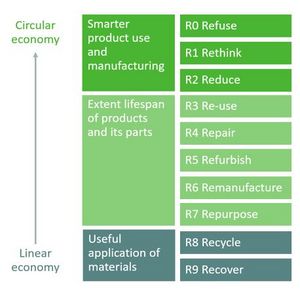9R-strategies explained
There exists a hierarchy of circularity strategies, different levels to reduce the consumption of natural resources and materials, and minimize the production of waste [1]. They can be ordered for priority according to their levels of circularity

Implementing CE-solutions: the 9R-strategies
Several circularity strategies exist to reduce the consumption of natural resources and materials, and minimise the production of waste. They can be ordered for priority according to their levels of circularity.
Ideally, all materials stay within the economic production and consumption system. As a rule of thumb, more circularity equals more environmental benefits. This ultimate circularity, in which a product chain is closed because the materials can be applied over and over again, while retaining their original quality. If these can be applied in a similar product while no additional natural resources are necessary, then waste is a concept of the past. However, this is very hard to achieve in reality and full circularity is therefore the highest level, or objective within a Circular Economy.
There exists a hierarchy of circularity strategies, different levels to reduce the consumption of natural resources and materials, and minimize the production of waste[1]. They can be ordered for priority according to their levels of circularity (Figure 1).
More information and examples with regards to these 9R-strategies can be found in the toolkit.
Within the FACET-project these circularity strategies are linked to the concept of value chains to make them more tangible.
References
[1] Figure: Potting, José, et al. Circular economy: measuring innovation in the product chain. No. 2544. PBL Publishers, 2017.

